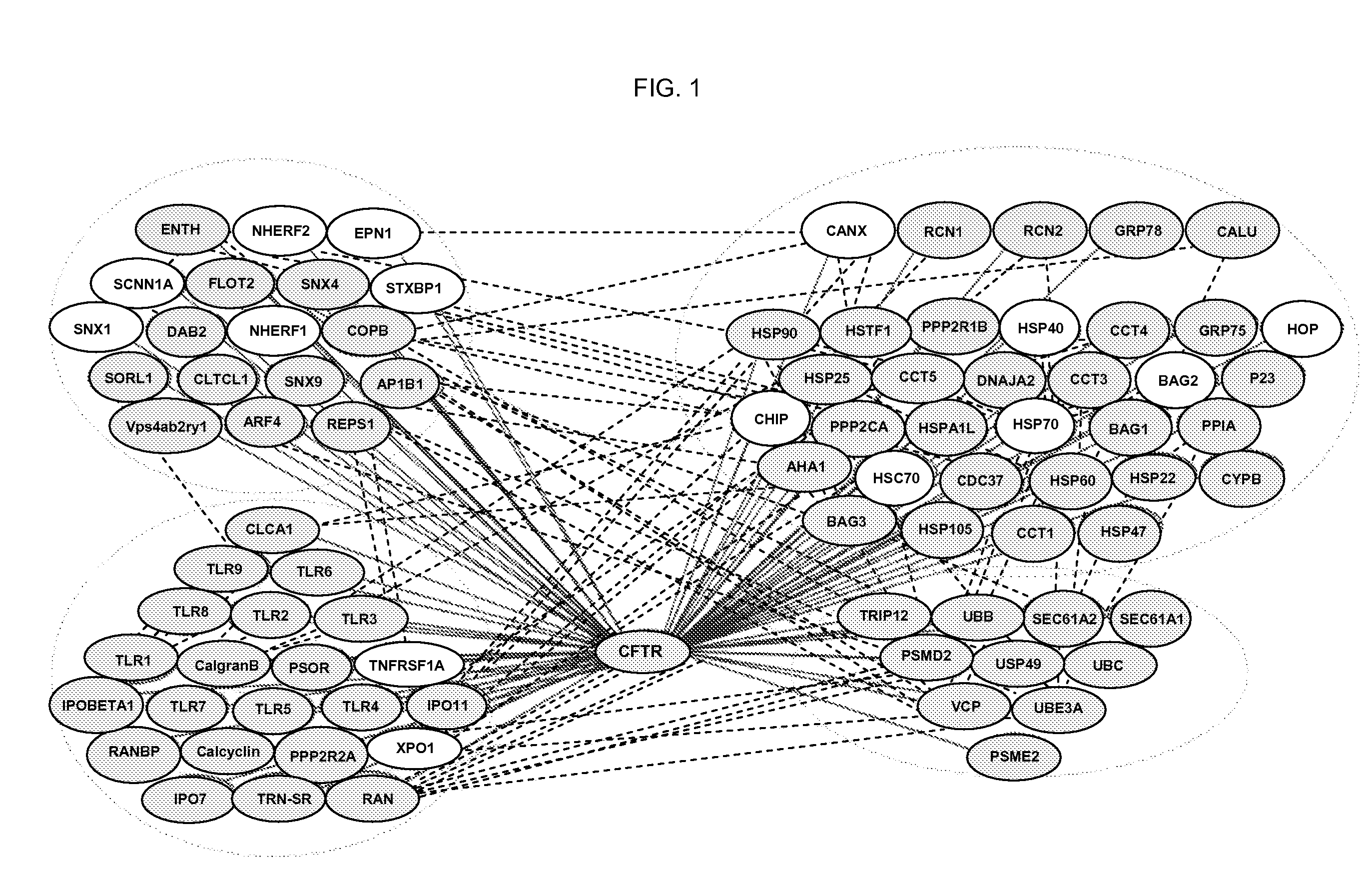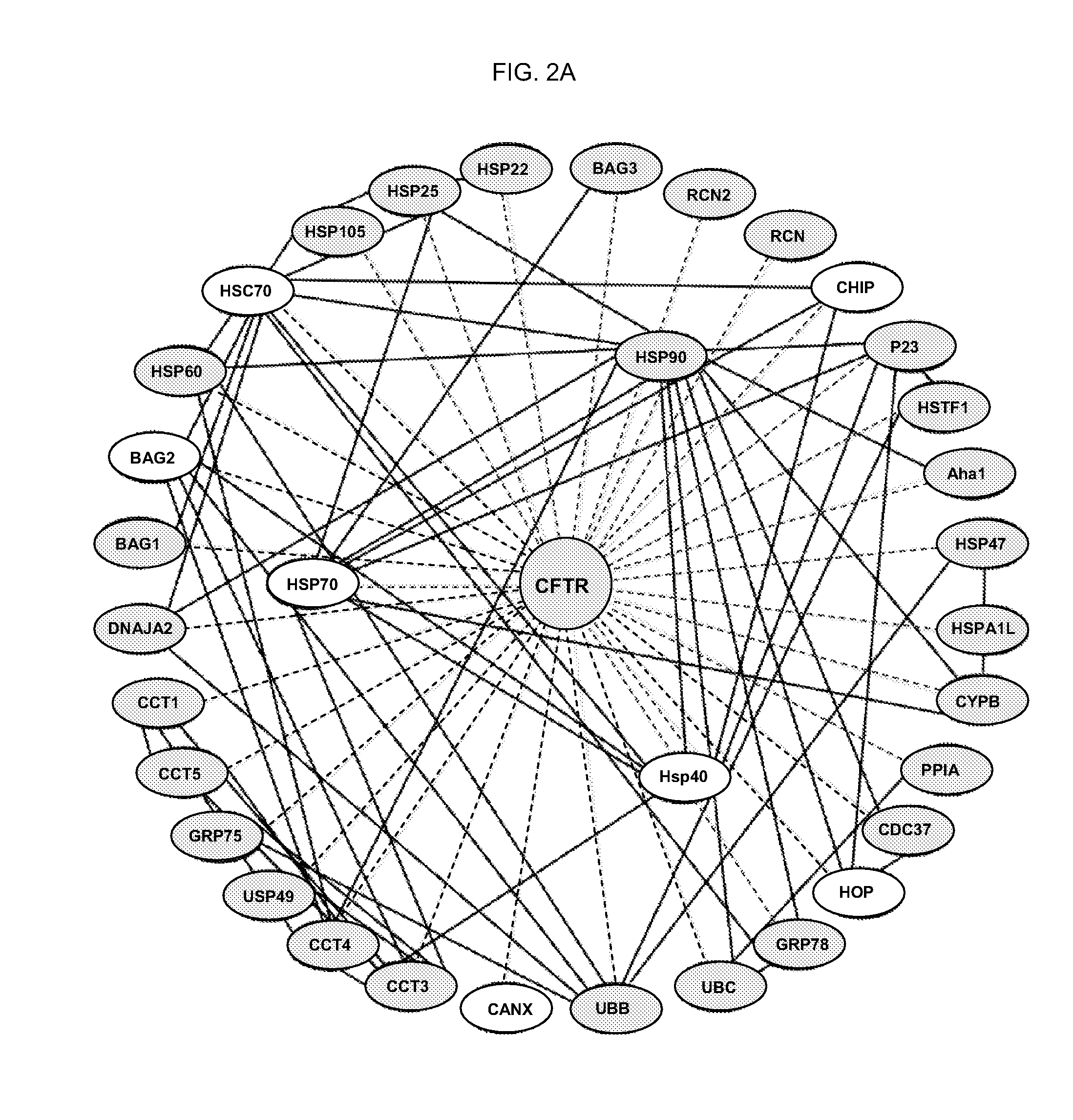Treatment of Protein Misfolding
a protein misfolding and disease technology, applied in the field of protein misfolding disease treatment, can solve the problems of loss of function phenotype, development of cystic fibrosis in human subjects, and excessive introduction of inhibitors or antagonists into cells, and achieves high biological activity and in vivo stability, effective inhibition of expression of aha gene, and efficient attenuation of hsp90
- Summary
- Abstract
- Description
- Claims
- Application Information
AI Technical Summary
Benefits of technology
Problems solved by technology
Method used
Image
Examples
example 1
CFTR Interactome
[0162] To define global protein interactions involved in CFTR trafficking and function in the exocytic and endocytic pathways, CFTR-containing protein complexes were immunoisolated from cell lines expressing wild-type CFTR (see e.g., FIG. 1), protease digested, and the composition of the peptide mixture determined using multidimensional protein identification technology (MudPIT) (Lin et al., Biochim Biophys Acta 1646, 1 (2003)).
[0163] CFTR was immunoprecipitated from stable BHK cell lines over-expressing either wild-type or ΔF508 CFTR, or the Calu-3, HT29 and T84 cell lines expressing wild-type CFTR. Baby Hamster Kidney (BHK) cells stably expressing wt or ΔF508 CFTR were maintained in DMEM supplemented with F12, 5% fetal bovine serum (FBS), 100 units / ml each of penicillin and streptomycin (Pen / Strep), and 500 μM methotrexate (Xanodyne Pharmacal, Inc., Florence, Ky.). Parental BHK cells not expressing CFTR were cultured in the same medium except without methotrexate...
example 2
CFTR Spectra Linkage
[0181] From the wealth of interactions observed in the interactome (see Example 1), the basis for the loss of export of ΔF508 from the ER was examined as a means of understanding the most common form of CF. A change in protein folding energetics (Sekijima et al., 2005, Cell 121, 73-85; Strickland and Thomas, 1997, J Biol Chem 272, 25421-25424) in response to the Phe 508 deletion results in failure of ΔF508 CFTR to couple to the COPII budding machinery (Wang et al., 1998, FEBS Lett 427, 103), resulting in ER-associated degradation (ERAD) (Nishikawa 2005, J Biochem (Tokyo) 137, 551). Chaperone components that are currently thought to significantly affect CFTR folding through ERAD (Sekijima et al., 2005, supra) pathways include calnexin (Farinha and Amaral, 2005, Mol Cell Biol 25, 5242; Okiyoneda et al., 2004, Mol Biol Cell 15, 563; Pind et al., 1994, J Biol Chem 269, 12784) found in the lumen of the ER, as well as the cytosolic chaperone complexes Hsc-Hsp70 / 40 and...
example 3
CFTR and ΔF508 Localization and Interactions
[0185] To identify components in the interactome that may be involved in the failure of ΔF508 to couple to the ER export machinery, the proteomes of wild-type and ΔF508 CFTR immunoprecipitated from BHK cells were compared. The parent BHK cell line not expressing CFTR was used as a negative control for non-specific interactions (see e.g., FIG. 2).
[0186]FIG. 2 is a series of depictions of the ER folding network. Table 8 shows the results of an array of proteins recovered using MudPIT in BHK cells not expressing CFTR (control), or those expressing either ΔF508 or wild-type CFTR, arranged in the order of fractional sequence coverage by mass spectrometry.
[0187]FIG. 2A is a cartoon depicting a composite view of the network comprising the CFTR ER folding and degradation proteomes. Light gray edges indicate potential direct or indirect interactions with CFTR; dark edges indicate known physical interactions between components based on data from ...
PUM
| Property | Measurement | Unit |
|---|---|---|
| Fraction | aaaaa | aaaaa |
| Mass | aaaaa | aaaaa |
| Mass | aaaaa | aaaaa |
Abstract
Description
Claims
Application Information
 Login to View More
Login to View More - R&D
- Intellectual Property
- Life Sciences
- Materials
- Tech Scout
- Unparalleled Data Quality
- Higher Quality Content
- 60% Fewer Hallucinations
Browse by: Latest US Patents, China's latest patents, Technical Efficacy Thesaurus, Application Domain, Technology Topic, Popular Technical Reports.
© 2025 PatSnap. All rights reserved.Legal|Privacy policy|Modern Slavery Act Transparency Statement|Sitemap|About US| Contact US: help@patsnap.com



